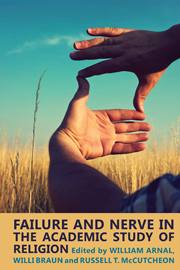Book contents
- Frontmatter
- Content
- Preface
- Acknowledgments
- Contributors
- Epigraph
- The Nerve of Donald Wiebe
- The Failure of Nerve in the Academic Study of Religion
- General Failures
- Catching Up with Marx: Truth, Myth, and the Niceties of “Belief”
- Fixed Geomorphologies and the Shifting Sands of Time
- A Critical History of Religion as a Psychological Phenomenon
- Everything Old Is New Again
- Revisiting the Confessional: Donald Wiebe's “Small ‘c’ Confessional,” Its Historical Entailments and Linguistic Entanglements
- Special Failures
- In Lieu of Conclusion
- Index of Authors
Fixed Geomorphologies and the Shifting Sands of Time
from General Failures
- Frontmatter
- Content
- Preface
- Acknowledgments
- Contributors
- Epigraph
- The Nerve of Donald Wiebe
- The Failure of Nerve in the Academic Study of Religion
- General Failures
- Catching Up with Marx: Truth, Myth, and the Niceties of “Belief”
- Fixed Geomorphologies and the Shifting Sands of Time
- A Critical History of Religion as a Psychological Phenomenon
- Everything Old Is New Again
- Revisiting the Confessional: Donald Wiebe's “Small ‘c’ Confessional,” Its Historical Entailments and Linguistic Entanglements
- Special Failures
- In Lieu of Conclusion
- Index of Authors
Summary
1. Introduction
Much of Donald Wiebe's work has challenged the shape and orientation of the field of Religious Studies. This has meant a herculean effort on his part to push the field more in alignment with a scientific study of religion. Like Wiebe, I too, as a poststructural feminist, have made efforts to shape the field, asking questions and providing analyses that veer from the mainstream. And, like Wiebe, I too have run into the field's failure of nerve to push beyond the status quo: unfamiliar theoretical premises and tools of analysis are often met with suspicion and rejection. In this chapter I will discuss my own efforts to bring a feminist and semiotic analysis to the field. To do this I will provide a context for the development of my own work, speak to the theoretical orientation I adopt and the kind of insights I think such an orientation provides, and lastly address change, resistance, and more change in the study of the systems of belief and practice otherwise known as “religion.”
2. What's in a Name?
Tradition, as Raymond Williams writes, is an active force in any social body, a force that is “the most powerful practical means of incorporation” (1977: 115).
- Type
- Chapter
- Information
- Failure and Nerve in the Academic Study of Religion , pp. 50 - 61Publisher: Acumen PublishingPrint publication year: 2012



